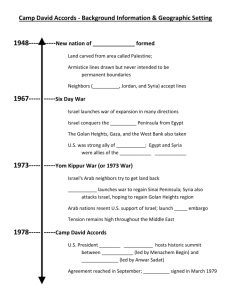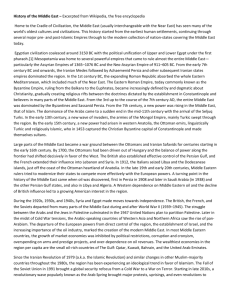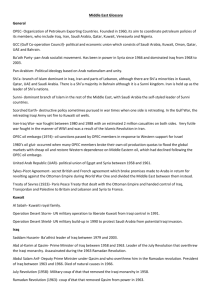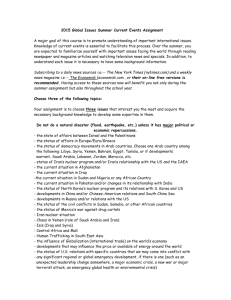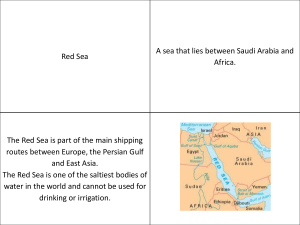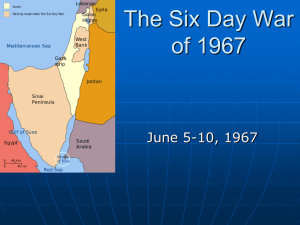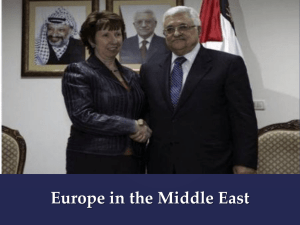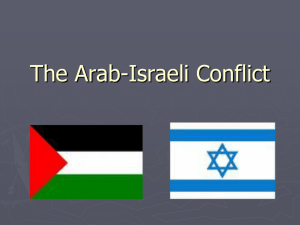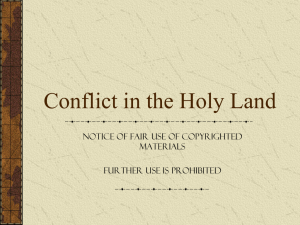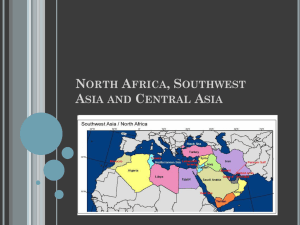The Arab-Israeli Conflict The Roots of the Conflict Both Jews and
advertisement
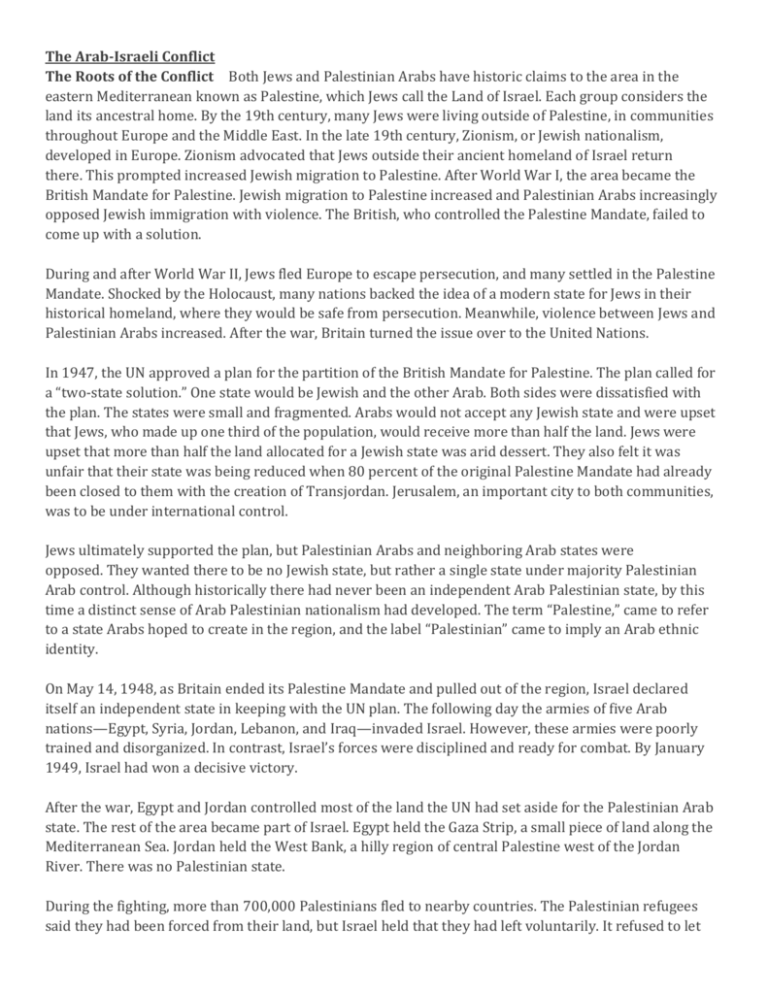
The Arab-Israeli Conflict The Roots of the Conflict Both Jews and Palestinian Arabs have historic claims to the area in the eastern Mediterranean known as Palestine, which Jews call the Land of Israel. Each group considers the land its ancestral home. By the 19th century, many Jews were living outside of Palestine, in communities throughout Europe and the Middle East. In the late 19th century, Zionism, or Jewish nationalism, developed in Europe. Zionism advocated that Jews outside their ancient homeland of Israel return there. This prompted increased Jewish migration to Palestine. After World War I, the area became the British Mandate for Palestine. Jewish migration to Palestine increased and Palestinian Arabs increasingly opposed Jewish immigration with violence. The British, who controlled the Palestine Mandate, failed to come up with a solution. During and after World War II, Jews fled Europe to escape persecution, and many settled in the Palestine Mandate. Shocked by the Holocaust, many nations backed the idea of a modern state for Jews in their historical homeland, where they would be safe from persecution. Meanwhile, violence between Jews and Palestinian Arabs increased. After the war, Britain turned the issue over to the United Nations. In 1947, the UN approved a plan for the partition of the British Mandate for Palestine. The plan called for a “two-state solution.” One state would be Jewish and the other Arab. Both sides were dissatisfied with the plan. The states were small and fragmented. Arabs would not accept any Jewish state and were upset that Jews, who made up one third of the population, would receive more than half the land. Jews were upset that more than half the land allocated for a Jewish state was arid dessert. They also felt it was unfair that their state was being reduced when 80 percent of the original Palestine Mandate had already been closed to them with the creation of Transjordan. Jerusalem, an important city to both communities, was to be under international control. Jews ultimately supported the plan, but Palestinian Arabs and neighboring Arab states were opposed. They wanted there to be no Jewish state, but rather a single state under majority Palestinian Arab control. Although historically there had never been an independent Arab Palestinian state, by this time a distinct sense of Arab Palestinian nationalism had developed. The term “Palestine,” came to refer to a state Arabs hoped to create in the region, and the label “Palestinian” came to imply an Arab ethnic identity. On May 14, 1948, as Britain ended its Palestine Mandate and pulled out of the region, Israel declared itself an independent state in keeping with the UN plan. The following day the armies of five Arab nations—Egypt, Syria, Jordan, Lebanon, and Iraq—invaded Israel. However, these armies were poorly trained and disorganized. In contrast, Israel’s forces were disciplined and ready for combat. By January 1949, Israel had won a decisive victory. After the war, Egypt and Jordan controlled most of the land the UN had set aside for the Palestinian Arab state. The rest of the area became part of Israel. Egypt held the Gaza Strip, a small piece of land along the Mediterranean Sea. Jordan held the West Bank, a hilly region of central Palestine west of the Jordan River. There was no Palestinian state. During the fighting, more than 700,000 Palestinians fled to nearby countries. The Palestinian refugees said they had been forced from their land, but Israel held that they had left voluntarily. It refused to let the refugees return to their homes, and their land came under the control of Israel. Palestinian Arabs who remained in Israel became citizens and today the Arab minority comprises approximately one fifth of the population of Israel. A comparable number of Jews—820,000—also became refugees as a result of the war. These Jews were persecuted and displaced from Arab states as part of the Arab rejection of Israel’s right to exist. The majority—586,000— resettled in Israel. Intermittent Warfare Israel and its Arab neighbors remained in a state of tension after the 1948 war. The Arab states refused to recognize the state of Israel or its right to exist. And Israel remained on guard against future attacks. In 1956, President Nasser of Egypt seized the Suez Canal from Britain and France. This ignited tensions in the region. Additionally, Egypt began to blockade Israeli shipping, considered under international law to be an act of war. In the second Arab-Israeli war, the British and French united with Israel to invade Egypt’s Sinai Peninsula in October 1956. Opposition from other nations, including the United States, forced the invaders to withdraw, however, by March 1957. The third war—known as the Six-Day War—took place a decade later. After the Suez conflict, Nasser viewed Israel as a mortal threat to Arabs. In the spring of 1967, he decided to act. He sent Egyptian troops into the Sinai Peninsula and closed off the Gulf of Aqaba, which was Israel’s outlet to the Red Sea. He also made military alliances with other Arab states, and publically declared his goal to destroy Israel. Israel viewed the naval blockade as an act of war and the other developments as a threat to its existence. In response to these actions and aggression from Syria, Israel acted on what it perceived as an imminent attack from its surrounding neighbors. It sent fighter jets to destroy airfields in Egypt, Syria, and Jordan and then launched lightning-fast ground attacks. In just six days, it won a resounding victory. After the Six-Day War, Israel controlled all of the former British mandate west of the Jordan river, including the West Bank, Jerusalem, and the Gaza Strip. It also occupied the Egyptian Sinai and Syria’s Golan Heights, a hill region that looks down on northern Israel. Around 200,000 more Palestinian refugees fled to Jordan. It was a humiliating defeat for the Arab states. Six years later, in October 1973, Egypt and Syria launched the fourth Arab-Israeli war. By this time, Anwar Sadat had become the Egyptian president. He was determined to restore Egypt’s power and prestige. The Arab forces began their attack during Yom Kippur, the holiest day of the Jewish calendar. They caught the Israelis off guard, pushing them back in the Sinai and down from the Golan Heights. But Israel fought back and regained territory. A UN ceasefire ended the fighting, but did not bring a formal peace. The Struggle for Peace After the war, Egyptian President Anwar Sadat began to work for peace with Israel. In 1977, he stunned the world by visiting Jerusalem and speaking before the Israeli parliament. In that speech, he announced, “Today I tell you, and I declare it to the whole world, that we accept to live with you in permanent peace based on justice.” In exchange for peace, Sadat called on Israel to respect Palestinian rights and return Arab lands taken in the 1967 war. In 1978, Sadat and Israeli Prime Minister Menachem Begin (meh-NAH-hehm BEH-gihn) met for peace talks at Camp David, the U.S. presidential retreat in Maryland.These talks led to the Camp David Accords. Under this agreement, Egypt agreed to recognize Israel as a nation, and Israel agreed to return the Sinai Peninsula to Egypt. A peace treaty the following year ended three decades of war between the two nations. Other Arab states were furious with Sadat for making peace with Israel. Three years later, Sadat was assassinated. But the Egyptian-Israeli peace continued. Meanwhile, Palestinians took up the conflict with Israel. They resented Israel’s control over the West Bank and Gaza and many felt Israel should be destroyed. The main group spearheading this cause was the Palestine Liberation Organization (PLO), led by Yasir Arafat (YASS-sir AH-rah-fat). The PLO waged a political campaign to win support for a Palestinian homeland. But it also engaged in armed struggle, attacking targets and committing acts of terrorism in Israel and elsewhere. Israel fought back, bombing suspected PLO strongholds. In 1982, Israel invaded Lebanon, which was in the middle of a civil war, to strike at PLO bases there. World opinion and persistent guerrilla attacks eventually forced Israel to withdraw. A new phase of the conflict began in 1987 with a popular uprising called the Intifada. Palestinians in the West Bank and Gaza held strikes and demonstrations to protest Israeli policies. Youths hurled stones and bottles at Israeli soldiers. The PLO helped organize the uprising and supplied Palestinians with firearms. Israeli authorities cracked down by arresting, beating, and sometimes killing protesters and suspected terrorists. The Intifada went on for six years and finally prompted peace talks between the Israelis and the Palestinians. In 1993, a series of secret negotiations between Israel and the PLO in Oslo, Norway, produced the Oslo Accords. The PLO agreed to recognize Israel in return for Palestinian self-rule in portions of the West Bank and Gaza. Under the accord, a governing body called the Palestinian Authority would manage affairs in Palestinian-controlled areas. Many Palestinians and Israelis were unhappy with the accord, however. Both said it gave away too much to the other side. Prime Minister Rabin’s role in forging the agreement led to his assassination two years later by an Israeli extremist. After the Oslo Accord, the peace process stalled. Palestinians gained self-rule in some areas, but the handover of land was slower than expected. The PLO renounced violence, but Palestinian attacks on Israelis continued. In 1987, at the beginning of the Intifada, a Palestinian terrorist group known as Hamas was established. In the era after the Oslo Accord, this group and others launched terrorist attacks on Israel. In the fall of 2000, this violence increased during what became known as the Second Intifada. To bolster security, Israel constructed a barrier wall across the West Bank to prevent terrorists from being able to enter Israel easily. Unfortunately, the barrier isolated some Palestinian towns. Israelis also continued to build permanent settlements in the West Bank, further angering Palestinians. The ultimate goal of the peace process remains a two-state solution. But five key issues continue to hinder a peace agreement. One is persuading Arabs who reject Israel’s existence to recognize Israel’s right to exist as a Jewish state. A second issue is Israel’s control of land taken in the 1967 war. A third is the demand that Palestinian refugees and their descendants be allowed to return to land in Israel, an issue known as the “right of return.” A fourth is control over Jerusalem. And a fifth issue is control over scarce water resources in the Jordan River Valley. These issues have no easy solutions. But until they are resolved, peace between Israelis and Palestinians will remain elusive. Political Changes in Egypt and Iran Egypt and Iran play a key role in Middle Eastern affairs. Both are large, populous countries. In the decades since World War II, political changes in these countries have helped shape events in the Middle East. Nationalism in Egypt President Gamal Abdel Nasser and his nationalist policies defined postwar politics in Egypt. As a young army colonel in the 1940s, Nasser was troubled by political corruption and foreign influence in his country. He joined together with other army officers to seek change. In 1952, he helped lead a military coup that toppled the government. Two years later, he had taken charge of Egypt. Nasser wanted to build a strong, independent Egypt, free of Western control. He became a vocal critic of the West and a leader of the nonaligned movement during the Cold War. He also carried out social and economic reforms designed to promote national development along socialist lines. He passed land reform, nationalized private industries, and built a state-run economy. One of Nasser’s main goals was to build a large dam on the Nile River. The Aswan Dam would help prevent flooding and provide Egypt with hydroelectric power. Hoping to win Nasser’s loyalty, the United States offered loans to support this project. But Nasser angered the U.S. by forging ties with the Soviet bloc and communist China. When the United States withdrew its loans, Nasser struck back at the West. In July 1956, he nationalized the Suez Canal, which crossed Egyptian territory but had been controlled by the French and British. Thus began the Suez Crisis. In part due to a blockade Egypt had imposed on Israeli shipping, Israel invaded the Sinai Peninsula. Britain and France followed with their own invasion of Egypt. These actions provoked an international outcry and charges of imperialism. Fearing that the crisis could advance Soviet interests in the region, the United States put pressure on the invaders to withdraw their troops. Egypt kept the canal, and Nasser became a hero across the Middle East. Now recognized as the leader of the Arab world, Nasser began to promote the cause of Pan-Arabism. This was a movement to unite Arab countries around common goals. Nasser took control of the Arab League, a group of Arab member-states founded in 1945 with British support. The league was designed to promote Arab unity while keeping Arab states in the Western orbit. Nasser sought to mold the league to his own interests. Inspired by Nasser’s leadership, Syria joined with Egypt in 1958 to form a new Arab state, the United Arab Republic (UAR). This union was a testament to Nasser’s Pan-Arab vision, but it was flawed from the start. The two countries had done little to prepare for unification. Egypt—the bigger, stronger state— dominated the UAR.Syria was politically unstable and difficult to control. Many Syrians also resented Egyptian rule. In 1961, Syria pulled out of the UAR, and the union collapsed.Nasser’s image as an Arab leader suffered. Other setbacks followed. In 1962, Nasser sent Egyptian troops to fight in a civil war in Yemen. The war became a quagmire, with no end in sight. Again, Nasser’s image suffered. But the biggest blow came in the Six-Day War with Israel in 1967. The Arab loss hurt Nasser’s reputation in Egypt and the Arab world. He remained in office, but his power and stature were diminished. In 1970, he died of a heart attack. The presidents who followed Nasser largely abandoned his policies. President Sadat, who took over in 1970, made peace with Israel and developed close relations with the West. Hosni Mubarak (HOHS-nee moo-BAH-rahk), who took power after Sadat’s death, continued Sadat’s foreign policies. He ruled Egypt with an iron hand, holding on to power for three decades until public protests finally drove him from office in 2011. His overthrow was part of the “Arab Spring,” a broad, regional uprising against dictatorship that spread across the Middle East. Revolution in Iran Nationalism also surged in Iran after World War II. In 1951, the outspoken nationalist leader Mohammed Mossadeq was appointed premier, taking power from the shah of Iran. Two years later, however, Iranian conspirators aided by the CIA overthrew Mossadeq’s government. Mossadeq had angered Western nations with his nationalization of British petroleum interests in Iran. The shah of Iran, Mohammad Reza Pahlavi, regained power and ruled for the next 26 years. During the shah’s reign, Iran pursued a policy of modernization and close ties with the West. The economy grew rapidly, fueled by oil revenues. The shah undertook large building projects and expanded the military. While Iran prospered, however, its people enjoyed few political rights. The shah’s fearsome secret police—the SAVAK—cracked down on dissent. Nevertheless, opposition to the shah’s rule grew. Banned political groups met in secret. Members of Iran’s Islamic clergy—including top Shi’a clerics, called ayatollahs—lent their voices to the opposition. They saw the shah’s modernizing policies as a threat to Islamic values. One cleric in particular, Ayatollah Ruholla Khomeini (ho-may-NEE), attacked the shah’s secular rule. In 1964, Khomeini was forced into exile. By the mid-1970s, however, Iran’s economy was collapsing from overspending, mismanagement, and corruption. In 1977, the shah confessed to his chief minister:“We’re broke. Everything seems doomed to grind to a standstill.” The minister was even more frank: “It terrifies me that one day everything will simply cave in around us.” Meanwhile, popular discontent was rising. Strikes and protests broke out. From exile, Ayatollah Khomeini called for the shah’s overthrow and the creation of an Islamic state. Faced with mounting unrest, the shah lost control. In January 1979, he left Iran for medical treatments and never returned. Millions of Iranians flooded the streets in joyous celebration. Khomeini returned from exile to a hero’s welcome and soon took over as Iran’s supreme leader. The Iranian Revolution had just begun, however. The new regime established a strict Islamic theocracy. It imposed Islamic law in the courts and Islamic teachings in the schools. It enforced a Muslim code of conduct in public places. Women lost many of their civil rights. Critics of the regime were arrested or executed. Khomeini hoped to spread the Islamic revolution to other Muslim countries, which he believed were governed by corrupt, un-Islamic leaders. He also voiced a strong hatred for the United States, a country that had long supported the shah. In October 1979, the United States allowed the shah to enter the country for medical treatment. Soon after, Iranian militants seized the U.S. embassy in Tehran, the Iranian capital city. They took dozens of Americans hostage and held them for more than a year. The Iran hostage crisis finally came to an end in January 1981. By that time, war had broken out between Iraq and Iran. Iraq was led by Sunni Muslims, but the majority of the population was Shi’a. The vast majority of Iranians were also Shi’a. Iraqi leaders, fearing that the Iranian Revolution might spark a Shi’a uprising in their own country, invaded Iran in 1980. The war went on for eight brutal years, ending in a stalemate and ceasefire in 1988. Since then, Iran has remained a volatile presence in the Middle East. It has embraced the Palestinian struggle against Israel. It has also supported Lebanon’s Hezbollah guerillas, a Shi’a group that regularly attacked Israel. The United States has accused Iran of supporting terrorism and seeking to develop nuclear weapons. Iran has rejected these charges and had accused the United States and other Western nations of trying to block its legitimate rise to power. Oil and Power in the Persian Gulf Iran and Iraq are both part of the Persian Gulf region. This region has played a major part in world events over the past several decades, in large part because of oil. The countries of the Persian Gulf—which include Iran, Iraq, Saudi Arabia and a number of smaller Persian Gulf states—possess a major share of the world’s oil reserves. Oil has brought great wealth and many benefits to the region, but it has also contributed to conflict. The Oil States Oil production began in the Middle East in the early 1900s, but it was only after World War II that the region became a major oil producer. By 1960, Middle Eastern countries were supplying 25 percent of the oil in the non-communist world. A decade later, they were supplying half. The great majority of that oil came from the Persian Gulf region. Iran and Iraq were the first important oil producers in the Gulf. But they were soon eclipsed by Saudi Arabia, which was home to some of the largest oil fields in the world. Other Gulf nations, such as Kuwait and the United Arab Emirates (UAE), also became key producers. At first, Western oil companies controlled all production in the region. Over time, however, Gulf nations managed to gain increased control over their oil resources. They did this by forming their own oil companies and working together to negotiate new contracts with foreign firms. In 1960, major oil producers formed the Organization of Petroleum Exporting Countries (OPEC).The first five members of OPEC were Iraq, Iran, Kuwait, Saudi Arabia, and Venezuela. Eventually, other oil producers joined the group. OPEC members worked to regulate oil prices and production levels and to gain a larger share of oil revenues. A major turning point occurred in 1973, during the fourth Arab-Israeli War. To support the Arab cause and put pressure on Western countries, Arab members of OPEC placed an embargo on oil exports to countries supporting Israel. The Arab oil embargo, which lasted for six months, caused oil shortages in the West and a sharp rise in prices. This action brought Arab oil states increased income and greater power and influence. The Gulf nations used much of their new oil wealth for national development. They built roads, schools, airports, power plants, and other infrastructure that helped transform and modernize their societies. Economic growth was most evident among the states of the Arabian Peninsula, which changed radically over the course of a few decades. Saudi Arabia became a financial superpower, while the UAE boasted one of the highest standards of living in the world. Oil wealth also had some negative effects, however. Some countries became overly dependent on oil income. A fall in oil prices could have a severe impact on the economy. Oil states imported many workers from other parts of the world, but these workers had few rights and lived as second-class citizens. In addition, some countries, such as Iran, used oil revenues to buy weapons and expand their military. This military buildup fueled tensions in the region. Iraq Under Saddam Hussein One country that sought to expand its regional power was Iraq. With increased oil revenues, Iraq built a powerful army and began to seek a larger role in the Middle East. The architect of these changes was the Iraqi dictator Saddam Hussein. Saddam Hussein rose to power as a member of the Baath Party, a Pan-Arab socialist movement that took charge of Iraq in the late 1960s. Within a few years, he had become the dominant force in the Baath regime. Though he was not yet president, Saddam Hussein was the strongman who controlled the government and set its policies. In 1972, for example, he nationalized the oil industry, boosting oil revenues and enhancing his own power. He also tried to negotiate peace with the Kurds, a large ethnic group in northern Iraq that had been fighting the government for years. His efforts failed, however, and the conflict continued. In 1979, Saddam Hussein became president. His first task was to secure his grip on power. The main threat came from revolutionary Iran, which had called for the overthrow of the Iraqi government. Saddam Hussein believed that Iran was weak, and that a victory in war would boost his reputation in the Arab world. In September 1980, he invaded Iran. Saddam Hussein expected to win a quick victory, but he was sorely mistaken. Although the Iraqi army enjoyed early success, Iran rallied and regained lost ground. The Iran-Iraq War entered years of stalemate, and the death toll mounted. Toward the end of the war, Iraq used chemical weapons on the Iranians and on its own Kurdish population in northern Iraq. The losses were horrific. By 1988, when the two countries declared a ceasefire, nearly a million people had been killed or injured. The economic damage to both countries was enormous. The Persian Gulf War Saddam Hussein’s efforts to defeat Iran had failed, and Iraq’s economy was near collapse. But he still had a huge army, and his ambitions were undiminished. Two years later, he launched another invasion to recoup his losses and restore his image. This time his action would prompt a strong international response. On August 2, 1990, Iraq invaded the small Persian Gulf nation of Kuwait and quickly captured its capital, Kuwait City. Iraq had long claimed Kuwait as part of Iraq. Saddam Hussein also wanted to seize Kuwait’s oil and other assets. He did not expect the world to come to Kuwait’s aid. But again, he was badly mistaken. The UN Security Council imposed sanctions on Iraq, blocking its foreign trade and freezing its foreign assets. Saudi Arabia, which feared that Iraq might try to seize its oil fields as well, called on foreign countries to repel the Iraqi invasion. Under U.S. leadership, a coalition of forces from various countries— including Britain, France, and several Middle Eastern nations—was assembled to force Iraq out of Kuwait. Saddam Hussein was given a deadline of January 15, 1991 to withdraw from Kuwait, but he refused. The following day, the Persian Gulf War began with a massive aerial attack on Iraq and its forces in Kuwait. Five weeks later, the ground war began. Coalition forces swept through Kuwait and into southern Iraq, encountering little resistance. In just four days, the fighting was over. Iraq agreed to a ceasefire and abandoned its claim to Kuwait. Despite a crushing defeat and ongoing sanctions, Saddam Hussein’s regime survived. When Iraq’s Kurdish and Shi’a populations rose up in revolt soon after the war, Saddam Hussein carried out a brutal campaign of repression. More than 100,000 people were killed. Saddam Hussein held on to power until 2003, when a second invasion of Iraq by U.S.-led coalition forces overthrew his dictatorship. Iraq established a new, democratic government. But violence continued as Iraqi insurgents battled U.S. troops and government forces in a drawn-out war that involved the United States until late 2011.
